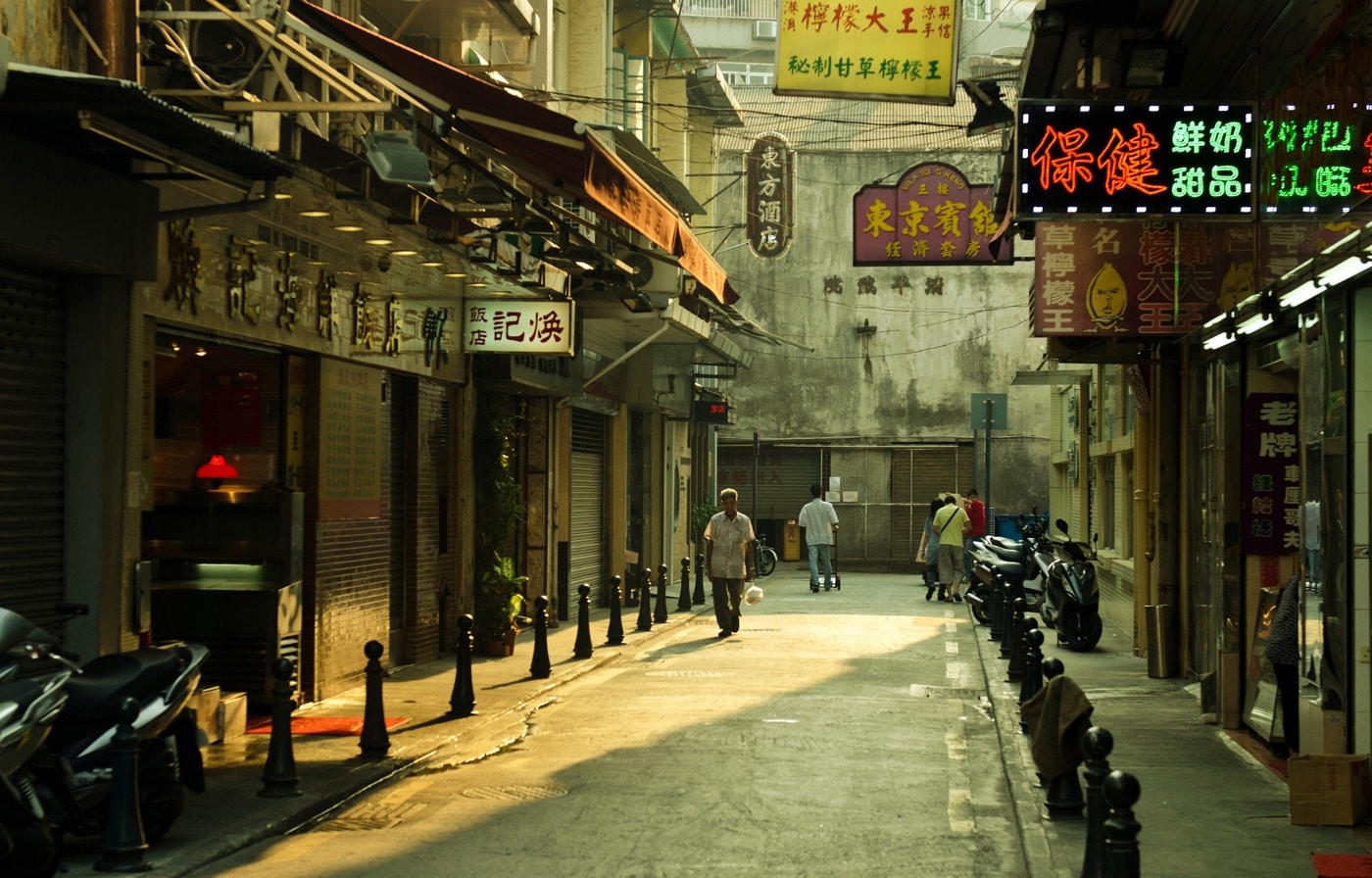Travel assumptions can often be misguided and my recent trip to Macau is one such example. But a happy surprise is a traveler’s true gift. Although I thought I knew the characteristics of this island, I was glad to discover a deeper and more complex, hybrid culture. While many of the over 28 million annual visitors come for the casino escapism (i.e. 33 casinos and over 62 hotels), it is gratifying to learn how much is being done to preserve and educate visitors about the island’s Portuguese history.
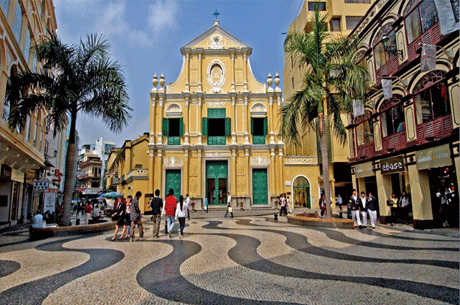
Macau is easy to reach from Hong Kong, where after your arrival at Hong Kong International Airport, a swift and buoyant ride on the Turbojet/SeaExpress will take you straight to the island. The SeaExpress has a departure gate in the airport, accessible even before you stand on line for Hong Kong immigration. The total commute was a mere 45 minutes, and quite pleasant. I settled comfortably into one of the plush ferry chairs and took photographs through the tinted windows. Forget the immigration and customs dance – you don’t even think about this until you get to Macau itself.
When I arrived, I was smack dab in the Peninsula, the oldest and most populated part of Macau. The Peninsula is also the island’s most diverse area, at least from a sightseeing perspective. This is where you can find the world’s largest nighttime bungee jumping spot: the top of Macau Tower, which boasts a thrilling drop of 1,109 feet. The temperature in the middle of October was warm, almost 80 degrees. The atmosphere was pleasantly busy but not crowded. Two wheelers and rickshaws whizzed by; shiny compact cars respectfully observed the speed limit.
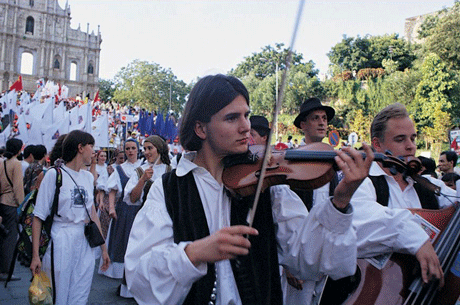
The Peninsula is home to several luxury boutique hotels including the Mandarin Oriental Macau which offers 168 doubles and impressive suites with tranquil views of Nam Van Lake and Macau Bay. The oldest casino on the island, the Grand Lisboa, is nearby. Lisboa is home to the biggest poker tournaments in Asia, and known for its private mahjong tables (mahjong, pronounced mah-zhong, is a Chinese game for four players, and played with 136 Chinese character tiles). The Peninsula is where the luxury hungry traveler can shop at Louis Vuitton by day and by night be enthralled by bungee jumping at the Macau Tower. The MGM Grand, the Mandarin Oriental’s neighbor, is where you can see an original Salvador Dali and several translucent chandelier gems by Dale Chihuly.
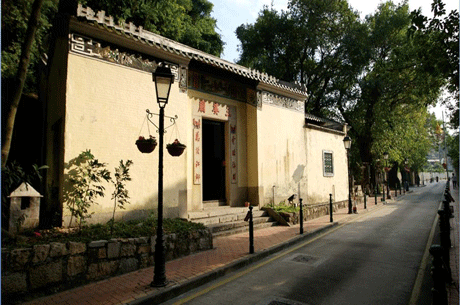
Many visitors choose to stay in the Peninsula because of its cozy vibe and edginess. The area attracts a well-heeled but younger, hipster crowd. The Tower is open well into the evening for bungee jumping, and those vying for that adrenaline rush can engage in weightlessness well until 7:00pm. If you’re feeling particularly adventurous, you can climb to the very top where they will serve you—no kidding– freshly brewed coffee.
The Tower Plaza, a sprawling space at the base, is lined with stores. It offers an ideal vantage point of Taipa Island, which is where you’ll find the Cotai Strip and the Vegas-style hotels. During my Peninsula stay, I was excited to take in some extraordinary fireworks displays from the annual Fireworks Competition. Certainly, the Macanese have their own unique and highly flavored cultural traditions, but the sparkling legacy, innovation and influence of China is palpable everywhere.
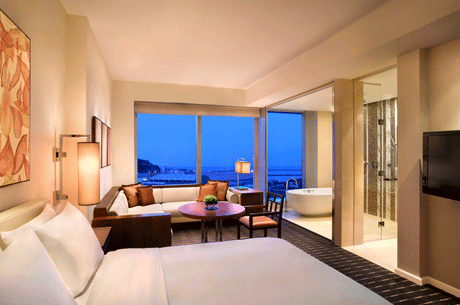
The Peninsula is thankfully not all manmade grandeur. A short cab ride to downtown Macau will take you to the Camoes Gardens, a dense, leafy wonder and one of the oldest parks in Macau. During the 18th century, these grounds belonged to a wealthy East India Company executive. Now, you can stroll shady pathways and meditate, read or simply observe the locals. Some practice Tai Chi at the crack of dawn. Others sing folk songs with musical instruments. “Locals view the gardens as extensions of their homes,” says Joao Sales, an executive with the Macau Government Tourist Office. The poet Luis de Camoes, whose bust can be found there, composed his epic Os Lusiades (Soul of Portugal) in the Grotto.
The Camoes Gardens is one place where you’ll forget you’re on casino island. Far from the madding crowd of high stakes poker and high rollers, this is where you’ll lose yourself in climbing hills studded with trees, and release your inner kid at brightly painted outdoor gyms.
Macau is doing everything it can to preserve the precious, authentic pieces of their cultural heritage and to show visitors how much more there is to the island apart from the glitz.
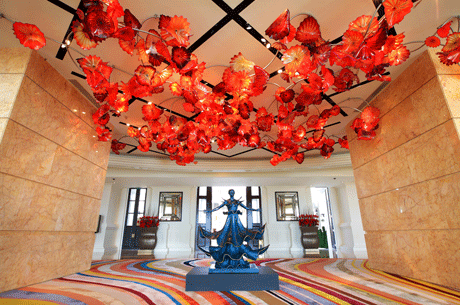
Many people have asked me what there is to do in Macau other than gambling; I like to point them towards landmarks like the Ruins of St. Paul Church, a UNESCO World Heritage Site. The Ruins are located in a lively, commercial section of downtown Macau, and are the island’s cultural magnet. What used to be the fully realized Cathedral of St. Paul (“Mater Dei”) is now a simple standing stone façade. Dedicated to Saint Paul the Apostle, the cathedral was destroyed by a fire in 1835.
With their Portuguese style architecture, The Ruins are the nerve center for Macau’s cultural appeal and they create a Baroque vibe in the area. Here tourists snap away and brides blush and pose for endless photographs. When you descend the many stone steps, you can lose yourself in the maze of narrow cobblestone streets and pastel colored churches. It’s a very special area to savor because for a single moment, you really feel like you’re in Europe, at least if you ignore the vendor signs with Chinese characters.
At the time of my visit Macau was celebrating the Mooncake Festival. A dessert that originated in China, the Mooncake is a delicacy that is traditionally served during lunar worship. It once contained hidden messages for the Portuguese military. What’s particularly endearing about Macau is how the people don’t hesitate to celebrate any occasion if given the chance; one area where gaiety is palpable is Senado Square, at the end of the cobblestoned walk from the Ruins and unmistakable because of its brilliantly painted pagoda. This is the hub of activity in downtown Macau, especially during festivities. During the Mooncake Festival, expect to find brightly colored paper lanterns festooning every building.

If you leave behind the Peninsula and drive towards Taipa Island (three bridges provide easy access), you’ll enter the area where glitz and glamour, casinos and skyscraper hotels reside. To say that the grandeur makes your head spin is an understatement. The Cotai Strip, modeled after the Vegas Strip, houses some of the biggest hotels and casinos in the world, including the world’s largest: the $27 billion Venetian Macau. From exciting entertainment like Cirque du Soleil to fine dining and luxury shopping, The Venetian will play Gulliver to your casino expectations. This is exactly what visitors expect when they come to Macau and the proof is in the numbers. Most of the over 28 million annual visitors come for the poker and roulette so expect to find most casinos packed to the brim.
There are other hotels to see and several other restaurants too, from the massive City of Dreams Triplex (featuring three distinct hotels with world class dining options) to the Galaxy Macau which houses the newly minted Banyan Tree Spa (a spa lover’s paradise).
At the end of the day, though, having visited the glamorous marble-lobbied hotels with rooms where no detail was left to chance, it was the cultural aspects of Macau that stuck with me most. To visit Macau thinking there’s nothing else to do except be a character in the Asian version of Hangover would definitely be a mistake. There is another side to the island: the history, culture and architecture are alive—especially in the older parts. Perhaps it’s time to leave misconceptions behind and be surprised yourself by the true gift of Macau.
The international dialing code for Macau is 853.
[alert type=white]
Where to Stay:
At the Cotai Strip
The City of Dreams – This triplex is imposing but serves your every need. It is comprised of three distinct hotels, including the Grand Hyatt Macau which itself has two wave-inspired towers and 791 guest rooms and suites). Don’t forget to check out the hip and trendy Beijing Kitchen restaurant which specializes in authentic northern Chinese cuisine. Crown Towers is another hotel part of the City of Dream, with 300 guest rooms. The rock and roll loving crowd will appreciate the Hard Rock Hotel, which is quite glitzy and edgy, and features a Rock Star Suite. Visitors to Macau should not miss the spectacle, The House of the Dancing Water, a one of a kind show created by Frank Dragone and worth the trip alone. The show resides at the City of Dreams.
(853) 8868 6688, Estrada do Istmo, Cotai, Macau
Galaxy Macau – This ginormous sprawl of a complex may be intimidating for some visitors, but think of it as a place that has everything you need, from arguably the widest selection of Chinese and Pan Asian cuisine in Macau under one roof to the Banyan Tree Spa. For spa, skeptics, a two hour long session in an individual bamboo-motif spa suite (which is as large as a house) and complimentary tea service at the end of the session will have you reach Nirvana pretty swiftly. Don’t forget to check out the Macallan Whiskey Bar & Lounge, the first Macallan branded Whiskey bar serving over 360 whiskeys to suit every type of traveler. Visit
853 2888 0888, Avenida de Cotai, Cotai City, Macau, www.galaxymacau.com
The Venetian Macau- The largest casino in the world, the Venetian Macau offers suites that span 70 square meters with sunken living rooms, lavish bath and private bedrooms. Ride on gondolas, shop to your pocketbooks’ content, and enjoy the sheer magnificence of prairie-like space. The Venetian offers 3,000 suites.
853 2882 8888, Estrada da Baía de N. Senhora da Esperança, www.venetianmacao.com
In the Peninsula
The Mandarin Oriental Macau – This boutique hotel leaves no stone unturned when it comes to service and presentation. The rooms are generous and many feature floor to ceiling views of the Macau Tower (the world’s tallest night time bungee jumping spot), and beautifully appointed rooms. Not to miss is the breakfast buffet at the Vida Rica Restaurant that features everything from pan fried noodles to Indian-influenced samosa; plus, the views of South China Sea aren’t too shabby.
800 526 6566, Avenda de Sagres, Nape, Macau, www.mandarinoriental.com/macau/
MGM Grand – Stay at this hotel for the sheer opulence and a serious art collection, from the Dale Chihuly glass displays to the Salvador Dali Statue in the lobby. The MGM Grand (adjacent to the Mandarin Oriental) is in the thick of all the shopping and high-end designer stores, and a short walk away from the Plaza and Kun Iam Statue.
(853) 8802 8888, Avenida Dr. Sun Yat Sen, NAPE, Macau, www.mgmmacau.com
Where to Eat:
Macau is also home to several restaurants and one popular place is the Michelin-rated Antonio located in Taipa Village. This is where visitors come for authentic Portuguese cuisine and Vinho Verde. Owner Chef Antonio Coelho is fiercely proud of his heritage but tells me, “I truly feel at home here.”
For something a little less apropos, try the Wynn Hotel’s starred restaurant Il Teatro, an Italian gem in a sea of local cuisine.
Don’t miss City of Dreams’ Treasure Palace and enjoy Cantonese and Chiu Chow cuisine made of fresh, local seafood and a seasonal menu.
Antonio: (853) 2899 9998, Rua dos Negociantes No. 3, Old Taipa Village, Taipa, Macau : www.antoniomacau.com
Il Teatro: (853) 8986 3663, Rua Cidade de Sintra, NAPE, Macau www.wynnmacau.com
Treasure Palace: (853) 8868 6661, The Boulevard, Estrada do Istmo, Cotai, Macau, www.cityofdreamsmacau.com
What To See:
A-Ma Temple: Situated close to the Maritime Museum, this temple is one of the few that is for both Buddhists and Taoists, and is the oldest in Macau. It is dedicated to the goddess Matsu who watches after seafarers and fisherman, and is buzzing with visitors who pray and offer incense sticks to the gods.
853 2831 5566, Rua de Sao Tiago da Barra, Macau
Kun Iam Statue: This 65.5 foot statue is an elegant curvaceous bronze statue and looks partly aquatic. Dedicated to the Goddess of Mercy, Kun Iam, the statue has a beautiful flower lotus base and is an ecumenical center. In the morning, you can find locals practicing yoga there.
The Ruins of St. Paul and Senado Square: Your trip to Macau won’t be complete without visiting these famous landmarks. Take a stroll down the steps from the Ruins of St. Paul to Senado Square and lose yourself in the Portuguese Baroque architecture.
Ave. De Almeida Ribeiro, Macao
[/alert]

